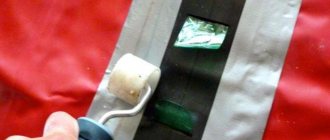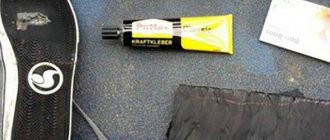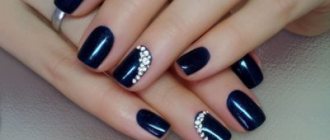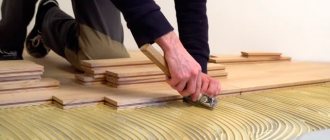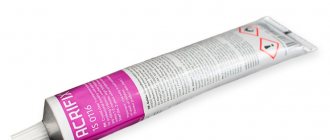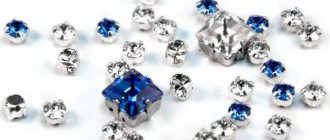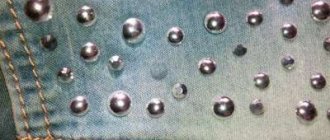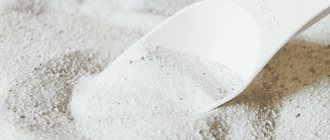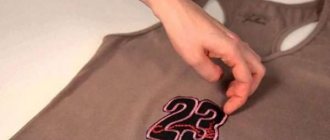Decorating with rhinestones is a luxurious way to add sparkle to any item. They sparkle beautifully in the light, creating the effect of magical shimmer as part of an ornament or as an independent accent. Stones can be sewn or glued. Sometimes the fixing layer is applied to the elements themselves, but in other cases a suitable adhesive is required.
How to glue rhinestones onto fabric at home
The way in which crystals can be attached to clothing or objects depends on the type of stone. They are glued and sewn. The first ones either have or don’t have an adhesive layer. If you have thermal film, you can glue the rhinestones to the fabric with an iron. For cold-fix rhinestones, a special adhesive emulsion is used.
The most expensive rhinestones are made of glass, and the cheapest are made of acrylic. Acrylic decor is not as durable.
If you decide to attach the pebbles with glue, you first need to select an adhesive emulsion and prepare the work surface. It is better to wash the item first. Then thick cardboard is placed under the area that will be decorated, the elastic material is stretched and fixed. Now the drawing is drawn with a pencil. Once everything is prepared, you can proceed to gluing.
The emulsion can be dripped either onto the fabric or onto the crystals. The first method is used if the pattern is extensive or the pebbles are too small. The second option is used for large stones and spot application. It is advisable not to stick the same crystal multiple times, otherwise the fabric may be damaged.
The work is performed according to the following algorithm:
- Drop the adhesive liquid onto the fabric or pebble.
- Grab the decorative element with tweezers or a wax stick.
- Place the decor on the desired area and press a little.
- Wait the time indicated on the emulsion box.
If the adhesive liquid was applied to the fabric, then the crystal must be placed in the center of the drop, which should be smaller than the pebble.
Gluing rhinestones to clothes with an iron is not always the best option.
For this purpose, crystals with a thermal film are selected, which becomes sticky when heated. There are 2 ways to place pebbles on clothes using an iron. The first is to lay out a pattern with crystals on clothes, cover the top with a cotton napkin, set the iron to medium temperature and press the stones with it. This method can be used on a non-slip surface.
This method can also be used when already hot crystals are laid out on clothes. The action algorithm is as follows:
- The pebbles are placed on the soleplate of the iron, sticky side up.
- A pattern is marked on the fabric.
- Plug in the iron and wait until the glue warms up.
- The crystals are grabbed with tweezers, quickly placed on the fabric, and then you need to press on them.
To make the task easier, you can use a special applicator with nozzles of different sizes. You just need to place the pebble in the device, heat it and transfer the crystal to the fabric. There are even models with a pump that draws in and holds the crystals. The applicator is used on delicate materials, on pile, such as velvet.
There are pebbles that already have an active sticky layer covered with a protective film. You just need to remove the protection, place the crystal on the fabric and press it down. The disadvantage of this decor is that it does not adhere firmly to clothing. However, if the decor needs to be applied quickly, then it is better to use such decorative elements.
Which rhinestones are more convenient and practical
Rhinestones are often used in sewing industries. You can also attach these stones to your clothes yourself. This way you can save money and get satisfaction from creativity. Based on the type of fastening to fabric, rhinestones are divided into two types:
- hot fix;
- cold fixation.
Each of these types of crystals has its own advantages and disadvantages. Cold fix rhinestones are attached to the fabric using special glue. They have a flat, smooth back surface. Glue is applied to it, and then the rhinestones are placed on the fabric. After several hours, the rhinestones adhere securely to the fabric. Cold-fix rhinestones are cheaper than hot-fix rhinestones. They can be used with different types of materials, especially thin and mesh ones.
There is already glue on the back of the thermal rhinestone. When heated, the substrate of such a crystal melts, and after cooling it is securely fixed to the material. This saves time if you need to attach a large number of rhinestones to clothing. Also, you will not have problems with applying glue: excess glue will not come out from under the crystals.
Before gluing thermal rhinestones at home, check whether high temperatures can be applied to your material. It is not recommended to attach such crystals to the following surfaces: plastic, vinyl, leather. You should also be careful when working with thin fabric.
Decoration with Swarovski crystals
Swarovski crystals are known all over the world because they are of high quality. However, in order not to spoil a thing decorated with such expensive decor, it must be applied correctly. Both clothes and objects are decorated with crystals. For hard surfaces, choose stones that have a flat side.
First, remove the fat layer from the surface on which the crystals are planned to be located. Epoxy glue will securely fix the pebbles. The adhesive composition is applied to the fabric, the crystal is quickly placed on it and fixed with pressure.
Adhesive rhinestones are placed on a dress or other clothing and ironed from the inside out.
Alternative to glue
You can decorate not only with glue. There are other types of rhinestones for which you do not need to purchase special adhesives.
Thermal rhinestones
They can be glued by heating with an iron or a special applicator resembling a soldering iron. The glue that is applied to the flat surface of the rhinestone melts when heated and becomes viscous, which allows them to be attached to the material.
Sew-on
For some fabrics these embellishments are more suitable. On thin and fleecy materials, rhinestones that are attached with glue do not hold tightly enough. For this type of textile, sew-on rhinestones are indispensable. The advantage is that you can always change the rhinestone to another place without spoiling the material.
The disadvantage is that it is more labor-intensive.
To make something decorated with artificial stones look expensive, you need to choose high-quality rhinestones. They undoubtedly have a higher cost, but they look chic for a long time.
How to sew a belt to trousers
How to sew gloves from knitwear
Rating of the top 5 adhesives for rhinestones
When choosing an adhesive liquid, keep in mind that the product should not contain acetone and acetic acid. You need to glue rhinestones onto fabric using a special adhesive emulsion.
Glue Moment Crystal
The glue is too toxic, so it can cause headaches during work. The adhesive liquid is transparent, easy to apply, stretches a little, so when it dries it forms a film on the surface. If this glue for rhinestones gets on the fabric, it will no longer be possible to remove it. Moment The crystal dries quickly, so it will also be impossible to change the position of the decorative stone.
Fevicryl Fabric Glue, India
The bottle has a convenient dispenser, making it convenient to apply the glue. The adhesive liquid is based on epoxy paste, which is odorless and non-stretchy. The substance is white in color, after drying it becomes transparent.
This glue is convenient for gluing rhinestones to fabric, because a few seconds after application they can be adjusted. After complete drying, the substance ceases to be plastic and does not deform clothing. This adhesive liquid allows you to design even a vertical surface. The glue dries completely after 24 hours; this period can be shortened by using a hair dryer.
After a week, clothes with rhinestones can be washed in cool water.
Textile adhesive e6000 craft, USA
The viscous liquid has no odor and can form threads between the drops. Glue residues can be easily removed from the fabric. The substance creates a strong and at the same time elastic connection. This glue is used for Swarovski crystals because its composition does not damage their foil surface. It has a water-resistant effect, so clothes can be immersed in fresh and salt water and machine washed.
Adhesive for rhinestones Danscouture, USA
This glue is based on water, so it does not emit any odor. After drying, the substance becomes transparent. The adhesive emulsion can be used on all types of fabric; the composition even allows you to glue rhinestones to the skin. Used to connect rhinestones that are flat on one side, decorating dance and gymnastics costumes.
Epoxy adhesive for Swarovski rhinestones CG 500 35, USA
This product is more suitable for jewelry making. At home, it is used to attach rhinestones to various hard objects.
The glue has proven itself in working with metal, glass, wood and porcelain surfaces, and artificial materials. It is not recommended to glue rhinestones onto fabric because it leaves stains.
How to glue hot fix rhinestones
In order to attach self-adhesive rhinestones, you will need an iron or a soldering iron for stones. You can also fix them with a heat gun or glue.
To attach such stones with an iron, follow these steps:
- Place your clothes on a flat surface or ironing board.
- On the costume, draw a sketch with a pencil according to which you will glue the stones.
- Place adhesive-backed rhinestones on top of the design.
- Before gluing thermal rhinestones to fabric with an iron, place a sheet of paper or a cotton napkin on them that does not fade.
- Heat the iron and place it on a piece of paper or fabric. First set the minimum temperature. Then it should be increased a little. The iron should be held in this position for 10-12 seconds.
In order to firmly fix hot-melt rhinestones, you must carefully monitor the temperature conditions and the level of pressure on the stones.
Caring for products with rhinestones and crystals
How long the decor will stay on things depends not only on the glue, but also on the fabric from which the product is made. When caring for and wearing clothing decorated with stones, you must follow the recommendations written in the instructions for the adhesive emulsion. However, there is a set of general rules that allow things to remain presentable longer:
- wet the product as little as possible;
- iron clothes through a thin cloth or gauze;
- When washing in a machine, you need to select a mode for delicate fabrics;
- do not add conditioner when washing;
- Do not allow the decor to overheat.
The best option is hand washing in water at a temperature not exceeding 30°C.
Adhering to film-adhesive tape
A convenient method of application for large patterns of stones that are difficult to carry one piece at a time. The gluing process goes like this:
- The stones are placed on adhesive tape with the adhesive base facing up.
- The film is turned over onto clothing and ironed.
- The film is removed.
When attaching crystals in a large group at the same time, you must remember that not all rhinestones can grip equally well and some of them will fall off over time.
How to securely fix the decor
If you purchased rhinestones that need to be glued cold, then you will need a special adhesive for the job. In some cases, it is enough to simply lay the stones on the clothes and use an iron to fix them. Craftswomen who make such decor to order use a special soldering iron. Replaceable attachments allow you to work with rhinestones of different sizes. The manipulation provides excellent results; the stones and glue warm up well, after which they will no longer be able to fall off even after washing.
A hot-melt glue gun fixes decorative elements with a special silicone compound, which melts and penetrates the fabric fibers, which ensures good adhesion. How to work with such a tool will be discussed below. Now we’ll tell you how to choose a composition for reliable cold fixation.
Something about rhinestones
Decorative crystals are made from materials such as glass, plastic, ceramics, crystal and acrylic. There are many varieties of shiny beads:
- Transparent and colored.
- With a muted shine (“satin effect”) or glossy.
- With a flat or embossed bottom.
- Some types of rhinestones are not intended for gluing, but for sewing. They have special holes for threads.
Advice! The nature of the shine, the material of the base and the body of the rhinestone are important indicators. The more important the event for which the decor is being prepared, the more expensive the rhinestones should be. The most pretentious option, of course, is Swarovski crystals.
With the help of rhinestones, unique and bright things, festive outfits and sparkling accessories are created. You just need to practice a little, buy good materials and let your imagination fly. An assortment of multi-colored crystals will help turn an ordinary product into a unique thing.
Test Two: Extreme Stretch
Each knitwear sample was stretched as much as possible in different directions until it stopped without violating the integrity of the material. Imitation of the event if, during operation, the product got caught on something and was pulled strongly or was quickly and carelessly put on.
Samples continue to live:
- No. 1 E6000 CRAFT;
- No. 7 Hot-melt rhinestones Preciosa (HotFix).
They also performed well under such inhuman treatment:
- No. 5 UHU Power glue;
- #4 Crystal Hobby.
There is almost nothing left from No. 2 Moment Crystal and No. 3 Fevicryl Fabric Glue.
Preparatory stage
Three factors play an important role in gluing rhinestones - good mood, inspiration and patience. But you also need to prepare thoroughly:
1. Idea. Think carefully about your future drawing or make a sketch on paper. A life-size sketch can be attached to the surface and adjusted to size.
2.Choose rhinestones that suit the size, color and style.
3. Fabric preparation. Lay out and gently smooth the base fabric. An important point - if the fabric is thin, it is better to place a sheet of paper between the layers of clothing in advance. Otherwise, the adhesive may penetrate too deeply and stick to the clothes.
4.Draw on the fabric with a pencil, tailor’s chalk, or a special disappearing marker the outline of the pattern according to which you are going to glue the rhinestones.
5. Arrange the rhinestones according to this pattern for visual perception.
You are ready? Let's start by telling you how to glue rhinestones onto fabric.
Gluing thermal rhinestones with an applicator
A rhinestone applicator is also called a hot-melt applicator or a soldering iron. This is a small heating device that can be used instead of an iron on finicky fabrics, such as velvet.
The advantages of the applicator include:
- Small size, compact: you can hold the fabric in your hands and stick the crystals directly without using an iron or table;
- Ease of use: the device heats up quickly, the set includes several attachments;
- Accurate result: thanks to its shape, the soldering iron heats the rhinestone pointwise and does not damage the fabric around it. They are also more convenient for gluing decor in hard-to-reach places.
Working with an applicator is easier and more accurate than using an iron.
You can attach it in 2 ways:
- Lay out the pattern on the fabric immediately, heat the soldering iron and apply it to the stones one by one. When heated, they will immediately attach;
- Heat the pebbles one by one with a thermal applicator and transfer them to place.
Cleaning fabric and rhinestones from glue residues
If suddenly a pebble comes off, you glue it unsuccessfully, or you accidentally stain the fabric with glue, don’t worry! There are ways to remove such glue stains.
Strong-hold adhesive is used to glue rhinestones. To avoid deformation of the fabric, try to first remove the rhinestones along with the layer of glue (except E6000 glue).
1.Saturate the fabric from the inside out with alcohol - this will weaken the adhesion of the glue to the material. After such impregnation, it is enough to pry the stone with something sharp, trying to pick up the layer of glue.
2. Another gentle method is freezing. The freezer compartment of a regular refrigerator is suitable for this. The structure of thermoactive adhesive is destroyed as a result of freezing. To do this, the product must be wrapped in plastic, placed in the freezer and left for 4-5 hours. Then take out and peel off the rhinestones. Usually they come off along with a layer of glue.
3. Chemical action on the glue with acetone or solvent. Apply the product to the inside of the product with a clean cotton pad. At this time, blot the front side with napkins.
4.Wipe the stain with turpentine a few minutes after application. This product can be used on both the back and front sides. Remove the stain carefully, without rubbing the glue over clean areas of the fabric. Residues of glue after the action of the solvent can be easily removed with a regular eraser.
To prevent the product being processed from deteriorating, precautions must be taken. Since many solvents discolor fabrics, all chemicals should be tested on inconspicuous areas of the product.
Test one - "CARPET"
Each sample was slightly stretched and fixed onto a small paint roller and rolled for five minutes with pressure and periodic slipping over a piece of carpet (my greetings to rhythmic gymnasts).
Samples came out without loss:
- No. 1 E6000 CRAFT;
- No. 3 Fevicryl Fabric Glue;
- No. 7 Hot-melt rhinestones Preciosa (HotFix).
No. 2 Moment Crystal suffered the greatest losses.
Alternative method of gluing using tape
This method is suitable for fixing a three-dimensional pattern, which involves the use of a large number of rhinestones. To do this, you should perform the following steps:
- Apply the design to the film and lay out the crystals along the contour. This is done on the sticky part. Place the stones with the shiny part facing the adhesive surface. As a result, the drawing turns out upside down.
- Cover the back of the crystals with glue and apply to clothing.
- When the composition dries, you should carefully remove the film. As a result, a pattern should remain on the fabric.
To check the reliability of fastening, shake the product a little. If some fragments fall off, it is recommended to glue them to the desired areas manually.
Choosing rhinestones
Mounting methods depend on the type of crystals. Therefore, in order to understand how to glue rhinestones, you need to divide the stones into types according to the principle of fixation on the fabric.
1.Cold fix rhinestones (NO hot fix)
- without glue on the backing. To glue the crystals to the surface, you must use specialized glue. Cold-fix rhinestones are used to decorate wedding and evening dresses, dance and stage costumes, swimsuits for fitness bikinis, rhythmic and artistic gymnastics, and acrobatics; shoes and bags, decorate phones, paintings and even cars.
2.Hot-melt rhinestones (hot fix).
They are used mainly for decorating fabrics. The base of the crystal is covered with a thin layer of glue. In order to fix them, you will need to use an iron, a steam generator or a special soldering iron. The glue melts under high temperature and fixes the rhinestones on the surface of the product. Below we will look at how to glue hot-melt rhinestones.
What will you need?
Minimum effort, time and materials and tools:
- set of rhinestones;
- iron;
- item made of suitable fabric;
- several sheets of blank paper.
Advice! It is better to glue decorations onto a finished piece of clothing - cutting and sewing already decorated fabric is inconvenient. It is recommended to pre-wash the item, and immediately before work, remove dust particles and lint with a clothes roller.
